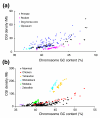CpG island density and its correlations with genomic features in mammalian genomes
- PMID: 18477403
- PMCID: PMC2441465
- DOI: 10.1186/gb-2008-9-5-r79
CpG island density and its correlations with genomic features in mammalian genomes
Abstract
Background: CpG islands, which are clusters of CpG dinucleotides in GC-rich regions, are considered gene markers and represent an important feature of mammalian genomes. Previous studies of CpG islands have largely been on specific loci or within one genome. To date, there seems to be no comparative analysis of CpG islands and their density at the DNA sequence level among mammalian genomes and of their correlations with other genome features.
Results: In this study, we performed a systematic analysis of CpG islands in ten mammalian genomes. We found that both the number of CpG islands and their density vary greatly among genomes, though many of these genomes encode similar numbers of genes. We observed significant correlations between CpG island density and genomic features such as number of chromosomes, chromosome size, and recombination rate. We also observed a trend of higher CpG island density in telomeric regions. Furthermore, we evaluated the performance of three computational algorithms for CpG island identifications. Finally, we compared our observations in mammals to other non-mammal vertebrates.
Conclusion: Our study revealed that CpG islands vary greatly among mammalian genomes. Some factors such as recombination rate and chromosome size might have influenced the evolution of CpG islands in the course of mammalian evolution. Our results suggest a scenario in which an increase in chromosome number increases the rate of recombination, which in turn elevates GC content to help prevent loss of CpG islands and maintain their density. These findings should be useful for studying mammalian genomes, the role of CpG islands in gene function, and molecular evolution.
Figures





Similar articles
-
Comparative analysis using K-mer and K-flank patterns provides evidence for CpG island sequence evolution in mammalian genomes.Nucleic Acids Res. 2013 May;41(9):4783-91. doi: 10.1093/nar/gkt144. Epub 2013 Mar 21. Nucleic Acids Res. 2013. PMID: 23519616 Free PMC article.
-
Diversification of CpG-Island Promoters Revealed by Comparative Analysis Between Human and Rhesus Monkey Genomes.Mamm Genome. 2020 Aug;31(7-8):240-251. doi: 10.1007/s00335-020-09844-2. Epub 2020 Jul 9. Mamm Genome. 2020. PMID: 32647942 Free PMC article.
-
Comparative analysis of CpG islands in four fish genomes.Comp Funct Genomics. 2008;2008:565631. doi: 10.1155/2008/565631. Comp Funct Genomics. 2008. PMID: 18483567 Free PMC article.
-
A review of computational algorithms for CpG islands detection.J Biosci. 2019 Dec;44(6):143. J Biosci. 2019. PMID: 31894124 Review.
-
CpG islands as genomic footprints of promoters that are associated with replication origins.Curr Biol. 1999 Sep 9;9(17):R661-7. doi: 10.1016/s0960-9822(99)80418-7. Curr Biol. 1999. PMID: 10508580 Review.
Cited by
-
Whole-Genome Sequencing and Characterization of Buffalo Genetic Resources: Recent Advances and Future Challenges.Animals (Basel). 2021 Mar 22;11(3):904. doi: 10.3390/ani11030904. Animals (Basel). 2021. PMID: 33809937 Free PMC article. Review.
-
DNA Methylation Patterns Associated with Tinnitus in Young Adults-A Pilot Study.J Assoc Res Otolaryngol. 2024 Oct;25(5):507-523. doi: 10.1007/s10162-024-00961-2. Epub 2024 Aug 15. J Assoc Res Otolaryngol. 2024. PMID: 39147981
-
Epigenetic Control of a Local Chromatin Landscape.Int J Mol Sci. 2020 Jan 31;21(3):943. doi: 10.3390/ijms21030943. Int J Mol Sci. 2020. PMID: 32023873 Free PMC article. Review.
-
Evolutionary conservation of DNA methylation in CpG sites within ultraconserved noncoding elements.Epigenetics. 2018;13(1):49-60. doi: 10.1080/15592294.2017.1411447. Epub 2018 Feb 6. Epigenetics. 2018. PMID: 29372669 Free PMC article.
-
An epigenetic hypothesis for the genomic memory of pain.Front Cell Neurosci. 2015 Mar 24;9:88. doi: 10.3389/fncel.2015.00088. eCollection 2015. Front Cell Neurosci. 2015. PMID: 25852480 Free PMC article.
References
-
- Lander ES, Linton LM, Birren B, Nusbaum C, Zody MC, Baldwin J, Devon K, Dewar K, Doyle M, FitzHugh W, Funke R, Gage D, Harris K, Heaford A, Howland J, Kann L, Lehoczky J, LeVine R, McEwan P, McKernan K, Meldrim J, Mesirov JP, Miranda C, Morris W, Naylor J, Raymond C, Rosetti M, Santos R, Sheridan A, Sougnez C, et al. Initial sequencing and analysis of the human genome. Nature. 2001;409:860–921. doi: 10.1038/35057062. - DOI - PubMed
Publication types
MeSH terms
LinkOut - more resources
Full Text Sources
Miscellaneous

